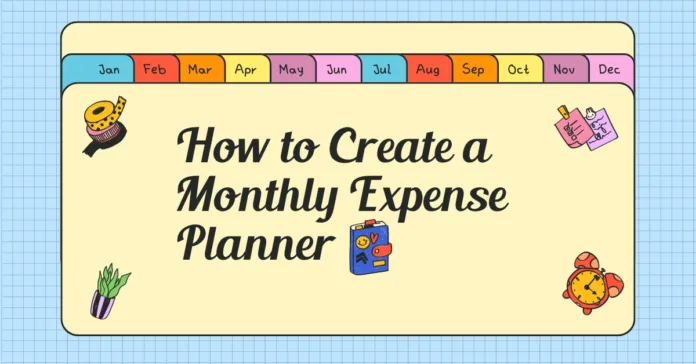Introduction
Happiness and financial well-being are two goals that many of us aspire to achieve. However, these goals can feel out of reach without a clear plan. A monthly expense planner can be vital in managing your finances, ensuring that you balance your needs, wants, and investments effectively. This structured approach fosters successful money-saving habits and brings a sense of accomplishment and happiness. In this blog, I will guide you through creating a monthly expense planner, dividing your expenses into categories, and developing habits to enhance your financial well-being and happiness.
Creating Your Monthly Expense Planner
Step 1: Categorize Your Expenses

To create a practical monthly expense planner, start by dividing your expenses into the following categories:
- Household: Includes rent or mortgage, utilities, groceries, and maintenance.
- Lifestyle: Covers entertainment, dining out, gym memberships, and personal care.
- Dependents: Encompasses children’s education, childcare, and elder care.
- Others: Includes EMI or loan payments, insurance premiums, and miscellaneous expenses.
Step 2: Plan for Your Needs

Your “needs” should not exceed 50% of your net monthly take-home income. These are essential expenses that are necessary for your daily living and well-being. Allocate your income to the following sub-categories:
- Household: 30% of your income
- Lifestyle: 10% of your income
- Dependents: 5% of your income
- Others: 5% of your income
Step 3: Plan for Your Wants
“Wants” are short-term desires and should not exceed 20% of your total net take-home income every month. This category includes items you would like to purchase or experiences you wish to have within the next few months to three years. Examples include a new TV, a mobile phone, or a vacation.
Step 4: Invest for the Long Term

Allocate 20% of your income to long-term investments. These investments are crucial for your future financial security and include retirement savings, long-term stocks, and bonds. This fund should be for goals that are ten years or more in the future.
Step 5: Enjoyment Fund

The final 10% of your income should be set aside as an enjoyment fund. This fund is for you to spend every month on something that brings you joy. It could be a treat for successfully sticking to your money-saving habits, like a spa day, a special meal, or a new hobby.
Developing Successful Money-Saving Habits
Following this structured plan will help you develop successful money-saving habits. Here are seven habits to reinforce this practice and ensure you remain happy and confident about your finances:
Habit 1: Develop a Successful Money-Saving Habit
By adhering to your monthly expense planner, you develop a disciplined approach to managing your money. This habit helps you save and gives you the satisfaction of seeing your financial goals met.
Habit 2: Enjoy Your Money Habits
Money management should not be a burden. Enjoy the process by celebrating small successes each month. Rewarding yourself helps reinforce positive habits and keeps you motivated.
Habit 3: Involve Every Family Member

Involving every family member in budgeting ensures everyone is conscious of their spending habits. It also fosters a sense of collective responsibility and teamwork towards achieving financial goals.
Habit 4: Document Everything
Write down all your expenses, savings, and investments in a diary. Documenting every detail helps you track your progress, identify areas for improvement, and celebrate your successes.
Habit 5: Consult a Financial Planner

A good financial planner can provide valuable insights and guidance tailored to your financial situation. They can help you set realistic goals, create a comprehensive plan, and make informed investment decisions.
Habit 6: Feel Confident and Great
Feeling confident about your finances comes from seeing tangible results. Each month, review your progress, acknowledge your achievements, and feel great about your disciplined approach to money management.
Habit 7: Increase Your Investments

As you receive salary increments, increase your investment contributions by 10%. This ensures that your savings and investments grow proportionately with your income, securing your financial future.
Summary
Creating a monthly expense planner is a decisive step towards achieving happiness and financial well-being. You can develop successful money-saving habits by categorizing your expenses, balancing your needs and wants, and setting aside funds for long-term investments and personal enjoyment. Involving your family, documenting your progress, consulting financial planners, and increasing your investments as your income grows will reinforce these habits. Embrace this structured approach to money management, and enjoy the confidence and happiness that comes with financial security.
Remember, the journey to financial well-being is a marathon, not a sprint. Take it one step at a time, celebrate your milestones, and stay committed to your financial goals. Here is to a future of happiness and financial well-being!
Action Plan for Implementing a Monthly Expense Planner for Happiness and Successful Money-Saving Habits
Action Plan
Step 1: Categorize Your Expenses
Start by listing all your monthly expenses and divide them into four main categories:
- Household: Rent or mortgage, utilities, groceries, and maintenance.
- Lifestyle: Entertainment, dining out, gym memberships, and personal care.
- Dependents: Children’s education, childcare, and elder care.
- Others: EMI or loan payments, insurance premiums, and miscellaneous expenses.
Step 2: Plan for Your Needs
Allocate 50% of your net take-home income to cover your essential needs. Break it down as follows:
- Household: 30%
- Lifestyle: 10%
- Dependents: 5%
- Others: 5%
Ensure these allocations cover all necessary expenses for your daily living and well-being.
Also read: 9 Personal Finance Mistakes to Avoid in 2024
Step 3: Plan for Your Wants
Dedicate 20% of your income to short-term desires. These are non-essential items or experiences you wish to have shortly, such as:
- A new TV
- A vacation
- Upgrading your mobile phone
Step 4: Invest for the Long Term
Invest 20% of your income in long-term financial goals. This includes:
- Retirement savings
- Long-term stocks and bonds
These investments should be aimed at goals ten years or more into the future.
Step 5: Enjoyment Fund
Set aside the final 10% of your income for personal enjoyment. Use this fund to reward yourself for successfully sticking to your money-saving habits. Possible uses include:
- Spa days
- Special meals
- New hobbies
How a Common Layman Can Exercise These Habits
Developing Successful Money-Saving Habits
- Track Your Spending: Start by tracking all your expenses to understand where your money is going. Use a notebook or a mobile app to record every transaction.
- Create a Budget: Create a monthly budget following the 50-20-20-10 rule based on your tracked expenses. Ensure you allocate funds to each category as outlined.
- Stick to Your Budget: Consistently follow your budget. Adjust your spending habits to stay within the allocated amounts for each category.
- Review Monthly: Review your spending at the end of each month and see how well you stuck to your budget. Adjust your budget for next month as necessary.
- Involve Family Members: Make sure every family member knows the budget and their role in sticking to it. This fosters a collective responsibility towards financial goals.
- Document Your Progress: Keep a diary of your expenses, savings, and investments. This will help you track your progress and stay motivated.
- Consult Professionals: Seek advice from a financial planner to tailor a plan specific to your financial situation and goals. They can provide guidance on investments and savings.
- Celebrate Milestones: Use your enjoyment fund to reward yourself for sticking to your budget and achieving financial goals. This positive reinforcement keeps you motivated.
- Increase Investments: As your income increases, ensure you proportionately increase your contribution by 10%. This will help you grow your financial security.
Pros and Cons of Such a Plan
Pros
- Financial Clarity: Categorizing expenses and following a structured plan provides insight into your financial situation.
- Control Over Finances: A budget helps you control your spending and avoid unnecessary debt.
- Goal-Oriented Savings: Allocating funds for both short-term and long-term goals ensures you are working towards financial security and desired milestones.
- Stress Reduction: Knowing you have a plan reduces financial stress and anxiety.
- Family Involvement: Involving family members creates a collective effort towards financial well-being and teaches valuable money management skills.
- Reward System: Setting aside funds for personal enjoyment ensures that saving money is not seen as a sacrifice but a means to enjoy life.
- Professional Guidance: Consulting financial planners can provide tailored advice and better investment strategies.
- Increased Savings: Regularly increasing your investment contributions ensures your savings grow with your income.
Cons
- Initial Effort: Setting up a budget and tracking expenses can be time-consuming initially.
- Discipline Required: Sticking to a budget requires discipline and may be challenging for those with impulsive spending habits.
- Family Resistance: Not all family members may be on board with the budget, leading to potential conflicts.
- Unexpected Expenses: Unplanned expenses can disrupt your budget and require adjustments.
- Income Variability: Sticking to a fixed budget can be challenging for those with irregular incomes.
- The temptation to Overspend: The enjoyment fund might tempt some to overspend, disrupting the budget.
- Professional Costs: Consulting financial planners may incur additional costs.
- Economic Changes: Inflation and economic changes can affect the effectiveness of the budget and investment plans.
Conclusion
Implementing a monthly expense planner is a practical and effective way to achieve financial well-being and happiness. You can develop successful money-saving habits by categorizing expenses, planning for needs and wants, investing for the long term, and setting aside funds for personal enjoyment. While some challenges exist, the benefits of financial clarity, control, and goal-oriented savings far outweigh the drawbacks. Embrace this structured approach to money management, involve your family, and consult professionals for tailored advice. Celebrate your financial milestones and enjoy the journey towards a prosperous future.
The author of this article, Taresh Bhatia, is a Certified Financial Planner® and advocate for female empowerment. For more information and personalized financial guidance, please contact taresh@tareshbhatia.com
He has authored an Amazon best seller-“The Richness Principles”. He is the Coach and founder of The Richness Academy, an online coaching courses forum. This article serves educational purposes only and does not constitute financial advice. Consultation with a qualified financial professional is recommended before making any investment decisions. An educational purpose article only and not any advice whatsoever.
©️2025: All Rights Reserved. Taresh Bhatia. Certified Financial Planner®
Subscribe Now for Upcoming Blogs!
[convertkit form=6555951]
📢 Join free live webinar —
Couple Finance Formula™ Register here




